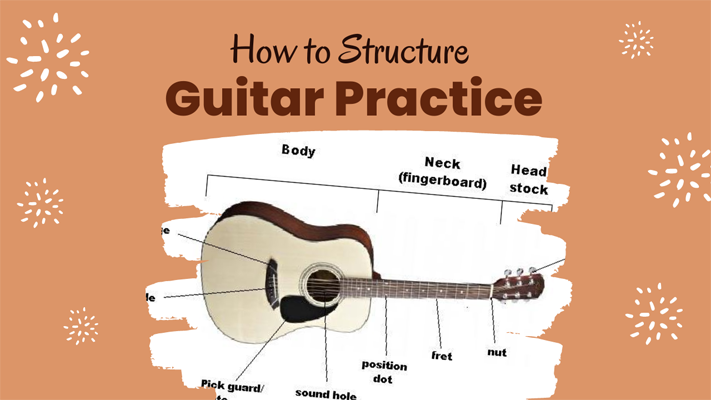
- Introduction
- What is the best way to structure guitar practice?
- How to Structure Guitar Practice: A Guide to Optimal Efficiency
- What muscles are employed during guitar playing?
- What are some effective techniques for practicing the guitar?
- How often should you practice the guitar?
- The benefits of structure in guitar practice
- The four types of guitar practice structures
- What role does rhythm have in guitar practice?
- How can you structure guitar practice to achieve the results you desire?
- Conclusion
Introduction
Separating your guitar practice into manageable chunks is one way to organize it. This can help you stick to a routine and avoid getting overwhelmed. Additionally, setting goals for your practice can help you stay on track. Try to aim for 1-3 hours of practice per day, and take breaks (10-15 minutes), so you don’t get too burnt out.
What is the best way to structure guitar practice?
Stress and uneasiness are normal in the present society. They can negatively affect your psychological wellness and even lead to actual issues. One of the least complexes is to get sufficient rest. Sleep is essential for maintaining hormone levels, repairing cells, and reducing inflammation. It also helps you stay focused and cognitively sharp.
Furthermore, the practice has decreased pressure chemicals and developed a state of mind. Studying a challenging activity that you enjoy can also help relieve stress. Finally, discussing your worries with a trusted friend or family can help manage them.
How to Structure Guitar Practice: A Guide to Optimal Efficiency
There is nobody ideal method for organizing guitar practice. However, following these guidelines can optimize efficiency and achieve the best results.
- First and foremost, choose an hour or two each day to devote to practicing the guitar.
- Besides, ensure that you are steady with your training plan.
- Third, break your training time into sensible lumps with the goal that you can follow the amount of progress you are making.
- Fourth, use devices like metronomes and cheat sheets to assist you with keeping on track and propelled during your training meetings.
- At long last, show restraint – it requires investment and works for working on as a guitarist!

What muscles are employed during guitar playing?
Guitar playing is a skill that requires a variety of muscles to be successful. The six muscles used most often when playing the guitar are the shoulder, arm, hand, forearm, bicep and triceps. These muscles can be worked individually or in combination to create complex finger patterns and chords. Working with each muscle group regularly is important to develop muscle memory and improve your guitar skills.
What are some effective techniques for practicing the guitar?
When it comes to practicing the guitar, a few things will help you get the most out of your time on the instrument. One of the main parts of rehearsing is laying out successful schedules. This can assist you with remaining on track and inspired and assist you with building new abilities all the more rapidly. Here are a few ways to make compelling practice regimens:
- Make sure your training space is set up appropriately. Ensure the room is agreeable and liberated from interruptions and that your hardware looks great.
- Choose songs that are challenging but also manageable. It’s important to challenge yourself, but don’t go too far beyond your current skill level.
- Take breaks often. If you are getting frustrated or bored, take a break to stretch or do something else to relax before returning to practice later.
How often should you practice the guitar?
How often should you practice the guitar? This question can be hard to reply to since everybody has various qualities and shortcomings. Be that as it may, assuming you hope to work on your abilities, it is vital to rehearse routinely.
There is no ideal number for how frequently you ought to rehearse, yet steady practice will assist you with fostering your melodic capacities. Attempt to figure out an opportunity every day when you can commit no less than 30 minutes to rehearse and increment how much time your abilities get to the next level.
The benefits of structure in guitar practice
Structured guitar practice can benefit both the beginner and experienced player. Following a routine can develop good habits and skills more quickly, making your playing more efficient and error-free. By categorizing your work, you can focus on specific skills without getting overwhelmed. Finally, a structured approach can help to build discipline and motivation.
The four types of guitar practice structures
To help you practice more effectively, here are some tips on how to structure guitar practice:
- Set a daily or weekly goal for how much you want to practice, and stick to it.
- Pick a normal that turns out best for yourself and stick with it.
- Break up your practice time into small, manageable chunks and focus on one goal at a time.
- Use warm-ups and cool-downs to keep your muscles warm and relaxed before and after practicing.
What role does rhythm have in guitar practice?
Rhythm is one of the main parts of guitar practice. Without mood, playing the guitar turns into much less tomfoolery and can turn out to be very baffling. The rhythm keeps you working as a guitarist and assists you with fostering your style. It’s also the foundation of many popular songs, so learning how to play rhythm correctly is essential if you want to be able to play along with the music.
Many guitarists think that learning how to play by ear is the best way to learn how to play rhythm, but this isn’t true. To figure out how to improvise, you should have the option to follow straightforward rhythms. Once you can do this, learning how to read music will be much easier.
How can you structure guitar practice to achieve the results you desire?
As with anything else in life, the key to achieving lasting guitar success is proper structure and planning. You don’t have to be a genius or a prodigy to know that practicing regularly and effectively can make a difference in your ability to play well and achieve your musical goals.
The following are seven tips that will help you structure your guitar practice session so that you can reach your goals:
- Set realistic goals. Don’t expect to be able to play fluently or perfectly right away.
- Break up the practice sessions into manageable chunks. It’s easy to get discouraged when you don’t seem to make any progress during practice sessions. Try breaking up your practice time into smaller chunks to prevent yourself from getting discouraged. For example, you may want to practice one new lick or one new chord change every 15 minutes. This will allow you to get in a few short sessions each day and won’t leave you feeling like you’re practicing for an hour and not making progress.
- Work on your technique. Many players get stuck on the technical aspect at the beginning of their practice routine. The thing to remember is that your technique is a tool that you can use to improve your playing as well as to communicate with your bandmates.
- The more you can work on your technique, the more comfortable you’ll become and the better it will be for all of you. If you don’t already have a metronome or click track, check out this article I wrote about digital metronomes.
- Get a feel for each instrument. This can be tricky at first, but as you practice your phrases more and more, you’ll get a better feel for each instrument. It’s a great idea to stop by the music store and pick up some sheet music for each instrument you’re learning, especially if you’re working on a wind ensemble.
- Go to your band leader or someone more experienced with the instrument you’re trying to learn.
- If you’re serious about learning the instrument, try to get private lessons with a teacher.
Conclusion
In conclusion, given that guitar practice can benefit both the beginner and more experienced players, it is important to structure practice in a way that works best for you. The most important thing is finding a method that allows you to progress at your own pace and helps you learn the material effectively.

Hi, This is Marco Welcome to GuitarsGeek, your ultimate destination for all things guitar. We are a team of passionate guitar enthusiasts who have come together to share our love and knowledge of the instrument. Cheers Amigos!






